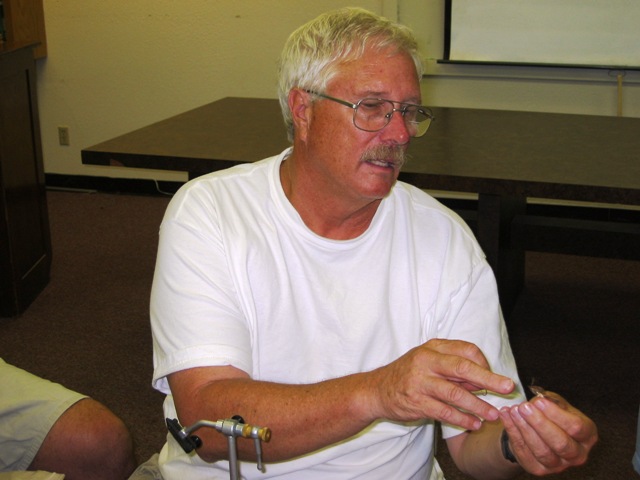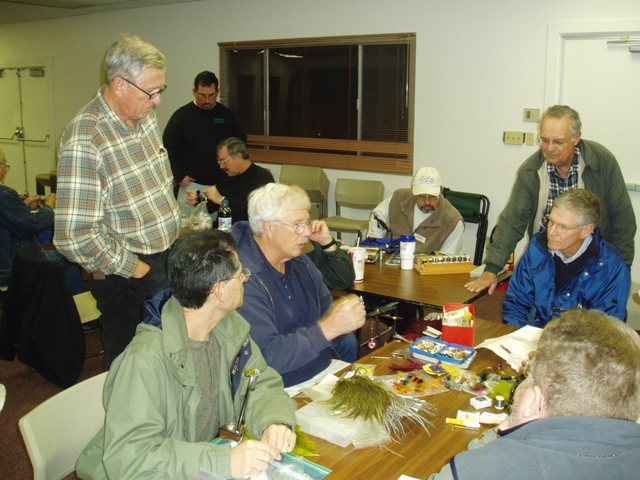|
FLY TYING JAM Jim Holmes & Pete Peterson Third Tuesday of the Month 6:30PM at the Activity Center |
||
|
Jim Holmes will be tying next month's Fly of the Month pattern and others that will work for that time of year and for the upcoming GBF fishout locations.
Any questions, give me a shout!
Jim Holmes 967-6709 |
Together with the fly tying jam I will be giving instructions on tying Bass and Saltwater flies. I will provide all materials for a fee of $3.00 per night. That is about 1/2 of what a single fly usually costs. Bring your own tools. This class is for intermediate tyers and up. It is NOT a beginner's class.
There should be enough time to tie 4-5 flies per meeting. If you have a favorite bass or saltwater fly that you would like to learn, I will gladly accept any requests. There is no sign up sheet for these classes. Come one - come all.
Pete Peterson |
||
|
Our Fly Tying Jam will be held on the third Tuesday of each month at the Folsom Lake Activity Center in Granite Bay starting at 6:30 or so...just remember that the gates close about 7:00PM so after that you are on your own!
The following table shows pattern recipes from Phil Fisher's presentation at GBF's March 2010 general meeting:
Warm-Water Corner by Pete Peterson
WARM WATER 101 - November 2010
Last month we went over streamers. I do not feel it was covered enough so this month we will go back to streamers and bring in bottom bouncing flies.
Many fishermen have their favorite material for bass. I started using chicken feathers that I pulled out of my grandmother’s chickens. Upon my return from Korea, I started tying with the materials that the inventor of the fly used. This was usually some sort of chenille (out of my grandmothers sewing basket) and buck-tail. Buck-tail was the norm for me for many years. All of my supplies at that time came from a company called Herter’s. It was a great company and they had everything. The quality of their goods by today's standard was very poor. Shortly after this, there was a great influx of different materials. One of the first new products was marabou. This was and is one of the truly great products for tying bass flies. However, most tyers do not put enough marabou on the hook. Marabou becomes very compact when wet, therefore I use two complete bunches on my larger flies. It makes the fly look too bulky and messy. Once you get it wet you will see what I am talking about.
After this, it was not possible to go into a fly shop and not see something new. This list would be endless so I am going to skip to today and the products I am using now.
Not long ago Enrico Puglisi came out with his product called EP Fibers. I tied some flies with this product and almost gave up buck-tail completely. Flies tied with this material will dry out on the back cast so that the forward cast has a fly unsaturated with water and it will cast further. Not too long ago a product (that I now use for at least 80% of my flies) called Farrar Blend came on the scene. This material is strong and has a beautiful sparkle to it. For smaller flies I like Craft Furr or Fox Furr. In a later issue, I will go over the many materials available.
Bottom bouncing flies are what I would tie on if I wanted to hunt only very large bass. My largest largemouth to date (15lbs-4oz.) was taken on a Whitlock Hair Jig. My second choice would be a Calcasieu Pig. To be effective, these flies must be fished on the bottom of the lake and retrieved with a short hopping motion. They should also be tied with a double weedguard. When the fly is on the bottom, the rubber legs of the Pig and the rabbit strip of the jig will move constantly. Largemouth have a very bad temper and will inhale these flies. You must retrieve SLOW. When the fly has been sitting on the bottom for awhile, give a short jerk on the line. This will cause the front of the fly to pop upward and it will cause a small cloud of dirt which the bass will clue in on.
Remember to set the hook on a largemouth using a “strip strike”. The rod will not set the hook without some force behind it. Smallmouth will set the hook by themselves quite often.
Tidbits – Always keep the fly line in a straight line from your reel to the fly. A largemouth can inhale, taste and spit out a fly in less than 1 second. This gives us a great advantage over hardware fishermen. Our materials are much more natural and the bass tend to hold them much longer than they would something made out of plastic or wood. A straight line method gives us a much better feeling of what is going on.
Pete Peterson Warm-water fly schedule: July Dan Blanton’s Whistler Aug Dan Blanton’s Sar-Mul-Mac Sept Fatal Attraction Oct Whitlock’s Hair Jig (this is the fly I caught a 15 lb bass on) Nov Whitlock’s Sheep Shad Dec Lefty’s Deceiver
Please remember that this is NOT a beginner's class. Neither are any of these flies hard to tie. There are several lake fishouts coming up and I will be there to help any way I can. Trivia: How big was the last bass you caught? If you do not have a scale, a very accurate method is: measure the girth of the fish at its widest point and square this measurement. Multiply this number by the total length of the fish from the tip of its head to the tip of its tail. Divide the number by 800. Thus a fish with a 20-inch girth and 22 inches long will weigh about 11 pounds. 20x20=400; 400x22=8800; 8800 divided by 800 is 11 pounds.
Free use of the Club’s fly tying vises and tools are also available. If you think you want to learn to tie flies, but don’t want to spend a lot of money to find out, contact Larry Lee and arrange with him to check out a vise and the tools you will need. Club members may keep them for thirty days at a time. Larry can be reached at Larrylee@l3rods.com or call him at (916) 962-0616. For any other questions about the Fly Tying Jam, you can contact Jim Holmes at (916) 967-6709 or jwholmesjr@aol.com |
|||

 Granite Bay Flycasters
Monthly Fly-tying Jam
Granite Bay Flycasters
Monthly Fly-tying Jam